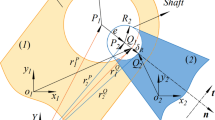Abstract
The reliability analysis is a quantification of the sources of failures in a product, with emphasis on the most significant contributors towards the overall product unreliability. As the reliability analysis of complex products is very crucial for analyzing the behavior of the products, many researches have been focused on it in recent decades with a result of many valuable contributions. However, current researches always focus on rigid product, while the product is always a rigid-flexible coupling multibody system, which could affect the accuracy of reliability analysis. This paper is devoted to virtual prototyping-based approach to a fuzzy Failure Mode, Effects, and Criticality Analysis (FMECA) with the consideration of rigid-flexible coupling virtual prototyping model. This paper discussed proposed approach in detail with three steps: the traditional FMECA method, the fuzzy FMECA method, and the rigid-flexible coupling-based analysis for FEMCA. The cold heading machine is given as an example which demonstrates that the methodology is helpful to reliability analysis. The physical prototyping is also carried out to demonstrate the product reliability.
Similar content being viewed by others
References
Hoyland A, Rausand M (2004) System reliability theory: models, statistical methods, and applications. Wiley-Interscience, NJ
Verma AK, Srividya A, Karanki DR (2016) Reliability and safety engineering. Springer London, London
Aramesh M, Rimpault X, Klim ZH, Balazinski M (2013) Wear dependent tool reliability analysis during cutting titanium metal matrix composites (Ti-MMCs). SAE Int J Aerospace 6(2):492–498
He X (2016) Recent development in reliability analysis of NC machine tools. Int J Adv Manuf Technol 85(1):115–131
Garcia PAA, Schirru R (2005) A fuzzy data envelopment analysis approach for FMEA. Prog Nucl Energ 46:359–373
Okaro IA, Tao L (2016) Reliability analysis and optimisation of subsea compression system facing operational covariate stresses. Reliab Eng Syst Safe 156:159–174
He B, Pan QJ, Deng ZQ (2018c) Product carbon footprint for product life cycle under uncertainty. J Clean Prod 187:459–472
Guaragni F, Schmidt T, Paetzold K (2016) Traditional and agile product development in a hyperconnected world: turning weaknesses into strengths. Procedia CIRP 52:62–67
Misra KB (2012) Reliability analysis and prediction: a methodology oriented treatment. Elsevier Science, Amsterdam
Schoefs F, Chevreuil M, Pasqualini O, Cazuguel M (2016) Partial safety factor calibration from stochastic finite element computation of welded joint with random geometries. Reliab Eng Syst Safe 155:44–54
Bowles JB, Pelaez CE (1995) Fuzzy logic prioritization of failures in a system failure mode, effects and criticality analysis. Reliab Eng Syst Safe 50:203–213
Sankar NR, Prabhu BS (2001) Modified approach for prioritization of failures in a system failure mode and effects analysis. Int J Qual Reliab Manag 18:324–336
He B, Zhou G, Hou S, Zeng L (2017a) Virtual prototyping-based fatigue analysis and simulation of crankshaft. Int J Adv Manuf Technol 88:2631–2650
Franceschini F, Galetto M (2001) A new approach for evaluation of risk priorities of failure modes in FMEA. Int J Prod Res 39:2991–3002
Gargama H, Chaturvedi SK (2011) Criticality assessment models for failure mode effects and criticality analysis using fuzzy logic. IEEE Trans Reliab 60:102–110
Keskin GA, Ozkan C (2009) An alternative evaluation of FMEA: fuzzy ART algorithm. Qual Reliab Eng Int 25:647–661
Chin KS, Chan A, Yang JB (2008) Development of a fuzzy FMEA based product design system. Int J Adv Manuf Technol 36:633–649
Kutlu AC, Ekmekçioğlu M (2012) Fuzzy failure modes and effects analysis by using fuzzy TOPSIS-based fuzzy AHP. Expert Syst Appl 39:61–67
Parracho SA (2012) Probabilistic priority numbers for failure modes and effects analysis. Int J Qual Reliab Manag 29:349–362
He B, Luo T, Huang S (2018a) Product sustainability assessment for product life cycle. J Clean Prod (In press)
He B, Niu YC, Hou SC, Li FF (2018b) Sustainable design from functional domain to physical domain. J Clean Prod 197:1296–1306
Ibrahim MH, Kharmanda G, Charki A (2015) Reliability-based design optimization for fatigue damage analysis. Int J Adv Manuf Technol 76(5–8):1021–1030
He B, Xiao JL, Deng ZQ (2018d) Product design evaluation for product environmental footprint. J Clean Prod 172:3066–3080
He B, Zhou G, Hou S, Zeng L (2017b) An approach to computational co-evolutionary product design. Int J Adv Manuf Technol 90:249–265
Abebe M, Park JW, Kang BS (2017) Reliability-based robust process optimization of multi-point dieless forming for product defect reduction. Int J Adv Manuf Technol 89(1):1223–1234
He B, Tang W, Cao JT (2014) Virtual prototyping-based multibody systems dynamics analysis of offshore crane. Int J Adv Manuf Technol 75:161–180
He B, Zhou GF, Hou SC, Zeng LB (2016b) Virtual prototyping-based fatigue analysis and simulation of crankshaft. Int J Adv Manuf Technol 88(9):2631–2650
Gao ZG, Zeng LB, He B, Luo T, Zhang PC (2018) Type synthesis of non-holonomic spherical constraint underactuated parallel robotics. Acta Astronaut (In Press)
He B, Wang J, Huang S, Wang Y (2015) Low-carbon product design for product life cycle. J Eng Des 26(10–12):321–339
Shabana AA (2013) Dynamics of multibody systems. Cambridge University Press
Zimmermann HJ (2011) Fuzzy set theory—and its applications. Springer Science & Business Media
Zhu CZ, Tang Q, Huang ZH et al (2009) Dynamic study for driver-motorcycle-road system with rigid-flexible coupling. Chin J Mech Eng 45(5):225–229 [In Chinese]
Cold HM (2014) Common faults of cold heading machine and its solution. RAYLITER. http://www.rayliter.com/html/192470552.html. Accessed 21 Aug 2014
Sun M (2006) Causes of common faults of automatic cold heading machine and their elimination. Fasten Technol 3:12–14
He B, Hua Y (2017) Feature-based integrated product model for low-carbon conceptual design. J Eng Des 28(6):408–432
He B, Tang W, Huang S, Hou S., Cai H. (2016a) Towards low-carbon product architecture using structural optimization for lightweight. Int J Adv Manuf Technol 83(5–8): 1419–1429
Funding
The work was supported by the National Natural Science Foundation of China (No. 51675319).
Author information
Authors and Affiliations
Corresponding author
Rights and permissions
About this article
Cite this article
He, B., Xue, H., Liu, L. et al. Rigid-flexible coupling virtual prototyping-based approach to the failure mode, effects, and criticality analysis. Int J Adv Manuf Technol 100, 1695–1717 (2019). https://doi.org/10.1007/s00170-018-2641-2
Received:
Accepted:
Published:
Issue Date:
DOI: https://doi.org/10.1007/s00170-018-2641-2




